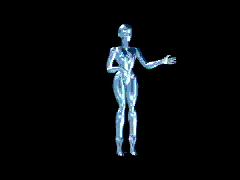I had taken a break from school to make some money, to be a student of life if you will, which didn't really turn out to be as much fun as being a college student. Between shifts at the Imperial Palace Hotel and Casino in Las Vegas, I would visit the local public library to research what my next (life) move would be. More importantly I was trying to figure out where I would finish the bachelors degree that I had started, yet paused.
 | ||
| This isn't the dancing robot I found in 1995. |
Once I found that place to continue my education I spent a lot of time aimlessly surfing about on the Internet in college. I found networks that informed the Rave community and electronic music scene on upcoming events. I wasn't a huge raver but hard disc recording interested me and it was fairly new. I recall to this day being blown away by a dancing robot on one of those rave web pages. Today the animated robot could be produced in minutes by a multitude of graphics programs, but at the time it was new and exciting. The animated GIF to the left is not the same robot but it reminds me of the one I saw so long ago.
The Early, somewhat Flat Internet
In those early Internet days the web's pickings were fairly slim. Web pages were mostly flat web documents that contained information that looked a lot like their paper counterparts, they were crude and archaic by today's Internet, but they were significantly different than anything before (or on paper). Pages laden with large (heavy) images were slow loading and decidedly not so fun. However, information about just anything was available to everyone. It was like a supernova of information exploding from those early web devs and bloggers.
Universities and Colleges also had information online that was much more current than the guide books on institutions of higher ed that resided on the library's shelves. This "live" aspect of the internet is it's real draw and appeal (just look at today's news aggregators and rapid moving social media giants like Twitter that push headlines to you faster than news outlets can deliver them to traditional formats).
The Real Time Juggernaut Internet
This live or "real-time" component is probably something that the next generations of Internet users will probably never think twice about going forward unless confronted by a natural disaster or power outage (dare I say a camping trip or prolonged stay in a dead zone).
It is so easy now to be "the source" or the "man or woman on the ground" that we the user can break stories that are as big as any news event in the last century. I rarely think about how it was to dial up a connection or wait for a web page to load.
*Information contained within these pages do not necessarily reflect the opinions or views of Schreiner University.

No comments:
Post a Comment